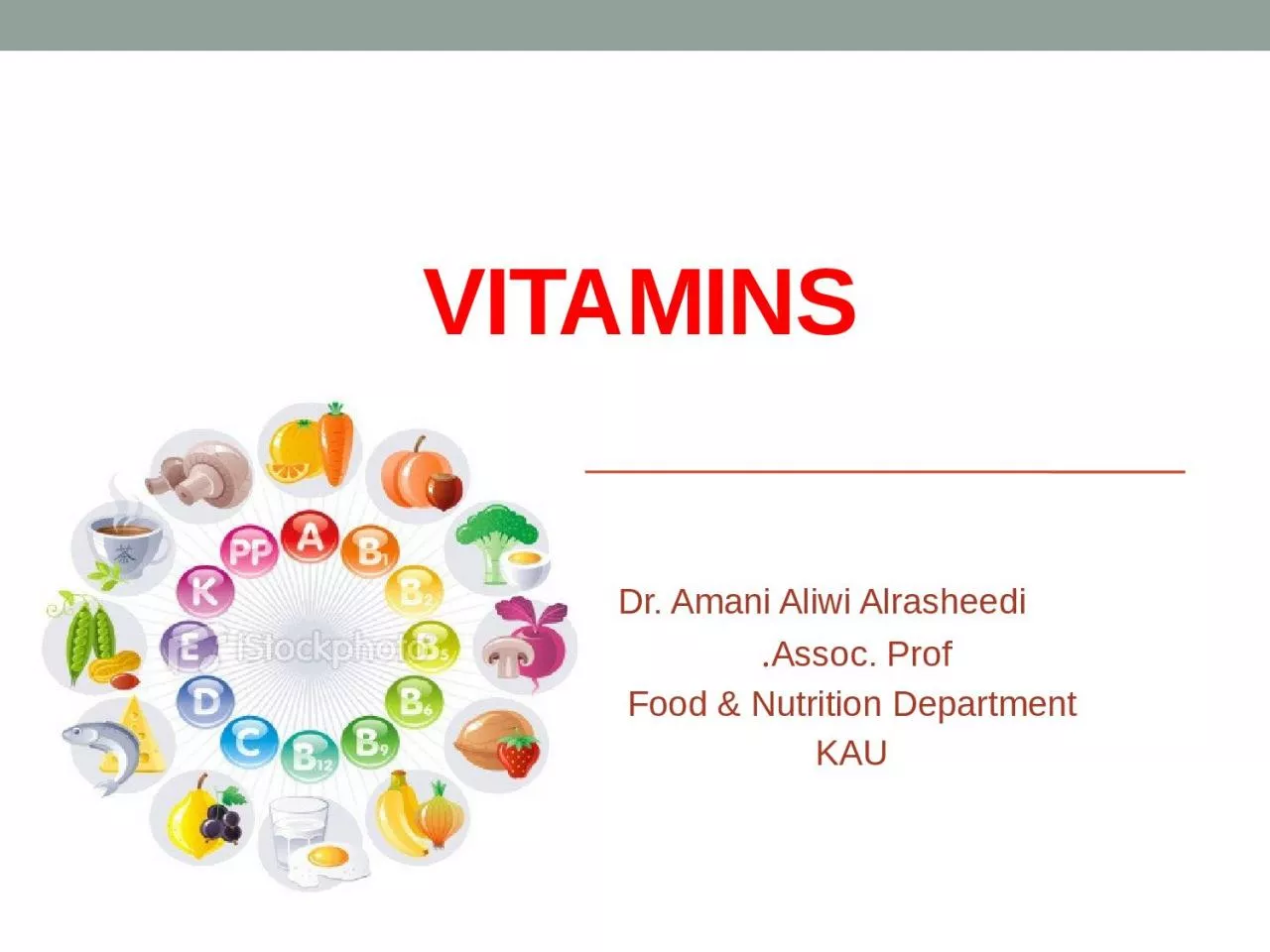

Aliwi Alrasheedi Assoc Prof Food amp Nutrition Department KAU Definition and Characteristics Vitamins are carboncontaining compounds organic that regulate a wide range of body processes ID: 1044075
Download Presentation The PPT/PDF document "Vitamins Dr. Amani" is the property of its rightful owner. Permission is granted to download and print the materials on this web site for personal, non-commercial use only, and to display it on your personal computer provided you do not modify the materials and that you retain all copyright notices contained in the materials. By downloading content from our website, you accept the terms of this agreement.
1. Vitamins Dr. Amani Aliwi Alrasheedi Assoc. Prof. Food & Nutrition DepartmentKAU
2. Definition and CharacteristicsVitamins are carbon-containing compounds (organic) that regulate a wide range of body processes. Vitamins are essential nutrients required in tiny amounts to perform specific functions that promote growth, reproduction or the maintenance of health and life.In 1912, Casimir Funk coined the term “vitamines” because these substances were required for life (“vita”) and contained nitrogen (“amine”). And “e” was dropped when studies showed that not all vitamins contained nitrogen.Almost everyone who eats a varied and healthful diet can readily meet their vitamin needs from foods alone.
3. Classification of VITAMINS 1- water soluble Absorbed into the blood stream directly and move freely within cells. Because storage of these vitamins in the body is limited, they must be consumed daily in the diet . when excess amounts are consumed, they are excreted in urineExamples of water soluble vitamins are:Thiamine- Riboflavin – Niacin – Pyridoxine – Cobalamin - Ascorbic acid – Biotin – Flolate & pantothenic acid
4. 2- Fat soluble Fat soluble vitamins are absorbed with fat into the lymphatic system and blood stream. Once in the blood stream, these vitamins need to attach to lipoproteins to be transported . Excess amounts of fat-soluble vitamins are stored in the liver and adipose tissue, so, these vitamins don’t need to be consumed daily in the diet.The fat- soluble vitamins are : vitamins A, D, E & K
5. Functions of vitamins AntioxidantsSome vitamins function as antioxidants ,which help protect the body from the instability of free radicals.Free radicals are unstable molecule fragments with one or more unpaired electron that are produced in cells as they burn oxygen during metabolism.
6. Other factors can also create free radicals in the body (UV radiation, smoking & air pollution). Each of these free radicals attempts to become stable by gaining an electron. While doing so they cause damage by oxidizing body cells. These damaged cells are contribute to aging and health problems.Antioxidants are substances that yield electrons to free radicals, helping to stabilize them and protect cells from damage. Vitamin C,E,A are all important antioxidants
7. CoenzymesEnzymes are proteins that catalyze chemical reactions within the body without changing themselves in the process.Many enzymes are not active without a co-enzyme, an organic molecule that makes up the non protein portion of the enzyme.Vitamins work as coenzymes, facilitating many important chemical reactions throughout the body
8. Food additivesVitamins are also used as additives in some foods to booster their nutritional contents. Examples include vitamin-fortified cereals and juices. As additives, vitamins may also be used to preserve foods, such as fish, and oils
9. Classification of VitaminsFat-solubleWater-solubleA,D,E,KVitamin C (ascorbic acid)Vitamin B1 (Thiamin)Vitamin B2 (Riboflavin)Vitamin B3 (Niacin)Vitamin B6 (Pyridoxine)Vitamin B12 (Cobalamin)Folic Acid or FolatePantothenic AcidBiotin